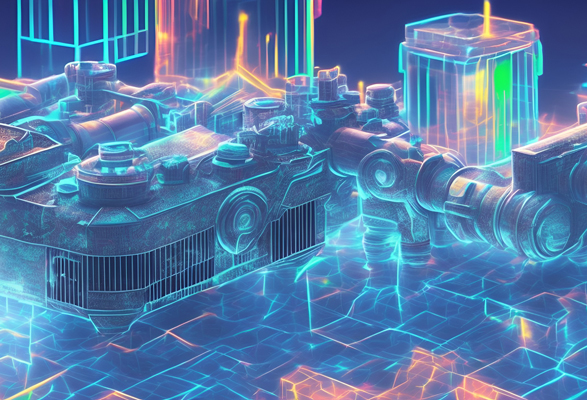Content
Author

Non-Fungible Tokens (or NFTs) are a crucial part of Web3 infrastructure with a variety of potential use cases. In this article, we will discuss how NFTs can empower the Metaverse, another prominent Web3 concept.
Understanding NFTs
Let’s start by establishing concrete definitions of what we talk about. NFTs (Non-Fungible Tokens) are unique digital assets stored on blockchain, a distributed ledger technology. Unlike cryptocurrencies, NFTs are not fungible, which means that each NFT represents a separate and unique object. This technology is often used to prove ownership of digital content and enable creators to monetize their work.
With the massive growth in the popularity of NFTs in recent years, several standards for NFTs have been developed to ensure compatibility between different blockchains. The two most popular standards are Etherium’s ERC721 and ERC1155.
Each token created under the ERC721 standard is unique and has its own identity, making it ideal for representing unique digital assets such as digital art and collectibles.
Such tokens have unique identifiers stored on the blockchain, allowing for the creation of verifiable ownership and trust.


The ERC1155 standard is more flexible and allows the creation of both fungible and non-fungible tokens on the Ethereum network, as well as the creation of multiple tokens within a single contract, these tokens can be identical (fungible) or unique (non-fungible). This makes ERC1155 standard ideal for GameFi where players can own different variations of the same item, or in collectibles, like sports cards.
Both ERC721 and ERC1155 are widely accepted in his NFT space and are used in many popular NFT marketplaces and platforms.
However, other standards are also being developed on various blockchain networks, such as Binance Smart Chain’s BEP721 and BEP1155 standards, and Flow’s Fungible Token and Non-Fungible Token standards.
NFTs have found many different use cases beyond digital art, like game assets or collectibles such as sports trading cards and limited edition merchandise, whose authenticity and origin can be verified on the blockchain.
Another emerging use case for NFTs is virtual real estate, where digital land can be owned, developed, and traded with NFTs. NFTs can also be used to represent ownership and royalties for songs and albums for musicians and to prevent scalping of tickets in the events industry. As the NFT ecosystem evolves, we can expect more innovative use cases to emerge in various industries.

The Metaverse
The Metaverse is a virtual shared space where people can interact with each other in an immersive environment. While the Metaverse is still in its early stages many companies and developers are already exploring ways to create immersive and interactive virtual environments. Major market players in the Metaverse space include tech giants such as Meta (formerly known as Facebook) which announced its commitment to building the Metaverse, and Epic Games which has been experimenting with different virtual immersive experiences.
Other notable examples include blockchain-based virtual worlds like Decentraland and Somnium Space, which enable users to buy, sell, and own virtual land and assets using cryptocurrency.
The Metaverse has an enormous potential to transform industries and economies by creating new opportunities for collaboration, trade and innovation. One example is enabling remote work and collaboration, allowing international teams to work together in a shared virtual space. The Metaverse also creates new e-commerce opportunities where users can buy and sell virtual assets.

The Synergy Between NFTs and The Metaverse
NFTs can be integrated into the Metaverse in a variety of ways, allowing users to own and trade their own valuable assets in a virtual environment. NFTs allow users to establish ownership and provenance of their virtual assets and increase their value. Additionally, this technology can enable interoperability between different virtual environments, making assets portable and usable across multiple platforms. Another notable feature is that NFTs are programmable, allowing complex rules and behaviors to be associated with assets.
Examples of the NFTs in the Metaverse include virtual land that users can own and develop, avatars that can be customized and traded, and virtual goods such as clothing and accessories. NFTs can also be used to create unique and immersive virtual experiences such as a virtual event that users of the Metaverse can attend and experience.
In our own project – Chimeras Metaverse NFTs are used to great effect as virtual assets (characters and items) that the players can purchase, trade or rent.

Web3 Development and NFTs
Web3’s development is focused on creating decentralized applications based on blockchain technology, giving users more security, transparency, and control. Web3 development principles include decentralization, open source collaboration, and user sovereignty prioritizing personal autonomy and privacy.
NFTs play a key role in Web3 development by allowing users to own and trade their own valuable assets within decentralized applications. NFTs can be used in her Web3 applications to represent ownership and provenance of digital assets, generate new revenue streams for developers, and encourage engagement with her users. However, using NFTs in Web3 development also presents challenges:
- High Gas Fees
- Interoperability Issues
- Sustainability and Environmental Impact Concerns
There are many ways NFTs can be utilized in Web3 development, such as creating new business models, enabling decentralized governance structures, and increasing user control over digital assets.

Future Possibilities
The future of NFTs and the Metaverse is highly speculative, but many experts believe these technologies will continue to grow. It is already heavily present in the gaming industry and in the art world, NFTs revolutionized the way art is created, sold, and owned.
In finance, NFTs can be used to represent ownership of assets such as real estate and stocks, creating new investment and trading opportunities.
However, there are also ethical and regulatory considerations for NFTs and Metaverses, such as environmental impact and the potential for fraud. Additionally, regulatory frameworks are still emerging and have not been properly developed yet, raising questions about privacy, intellectual property, and consumer protection.
As NFTs and the Metaverse continue to evolve, it will be important to address these ethical and regulatory considerations to ensure that the technology is deployed in a responsible and sustainable manner.

Conclusion
NFT is a truly revolutionary technology that allows for improvements in many different areas, democratizes trade and improves efficiency. That being said, there is still a long road and many improvements to be made for NFTs and the Metaverse to gain mainstream adoption.
Red Pill has extensive experience in creating NFT-centered projects and Metaverses. Contact us if your business needs a custom-made NFT or Metaverse product: https://redpilldev.tech/contacts/.






 t.me/redpilldev
t.me/redpilldev